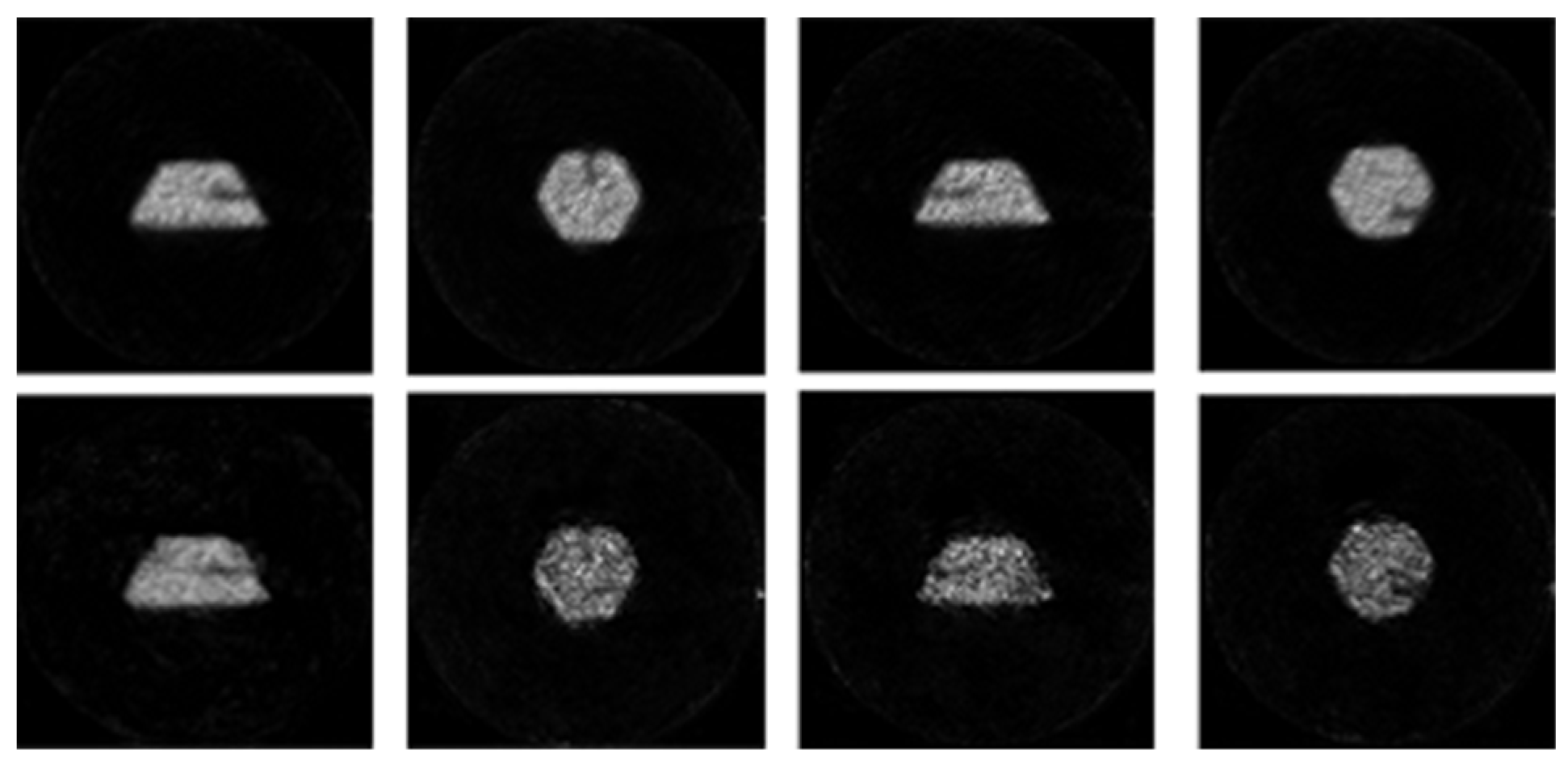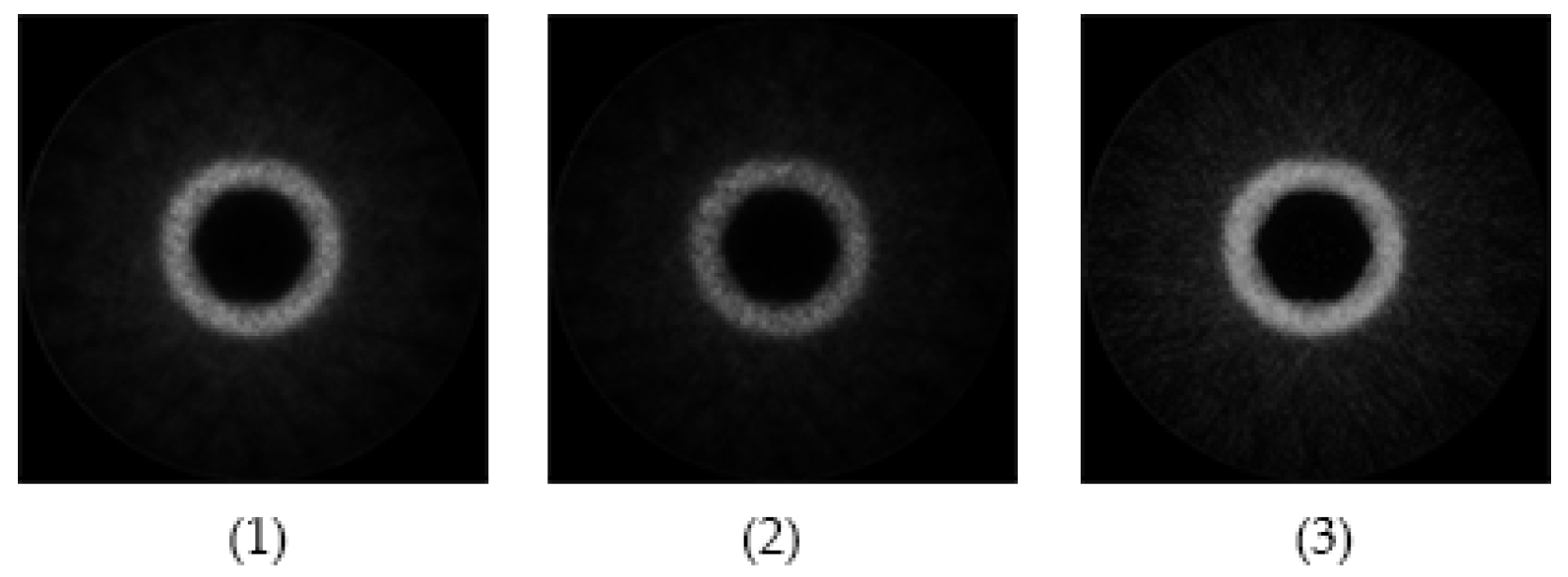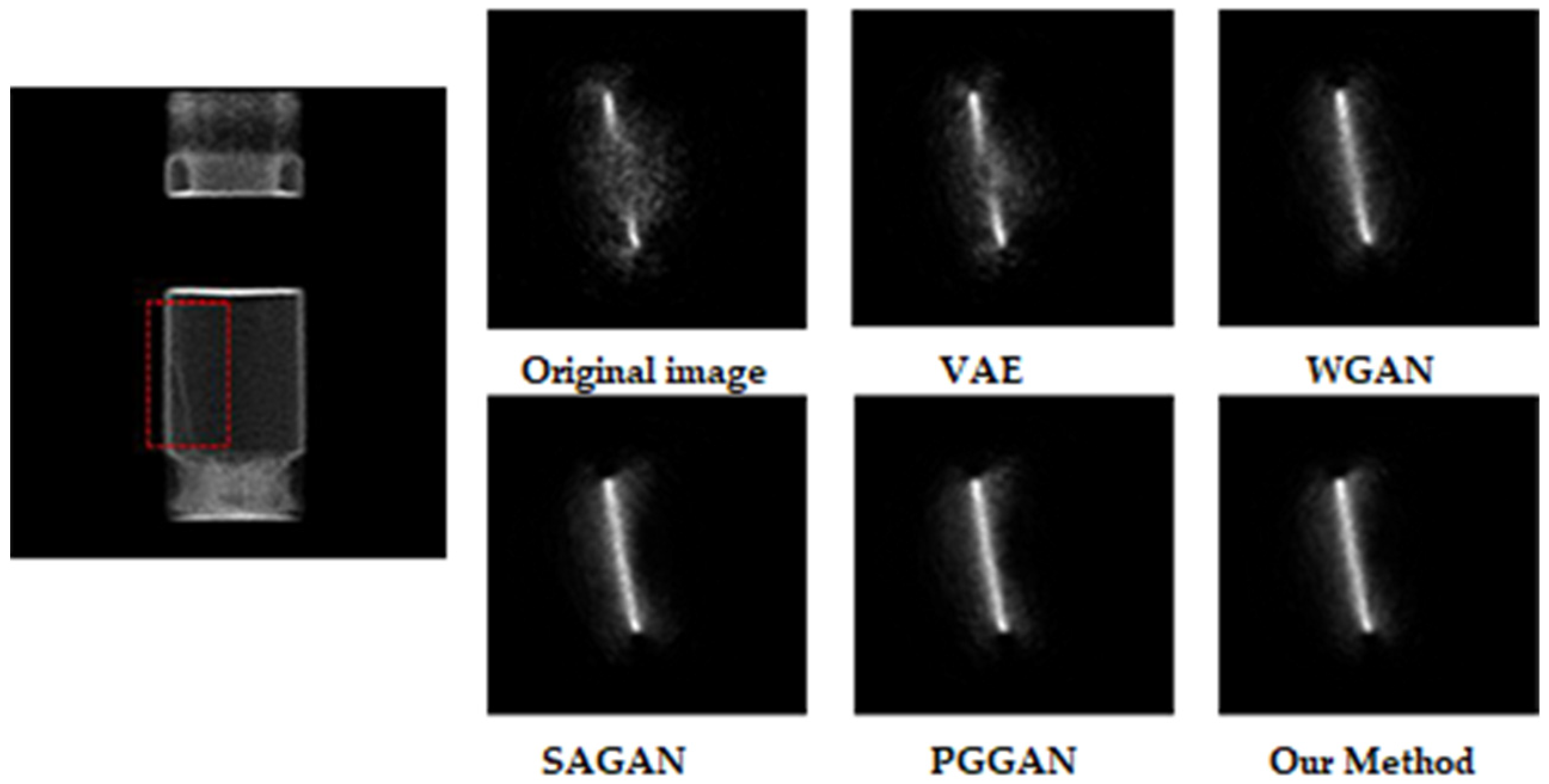Generative Adversarial Network of Industrial Positron Images on Memory Module
Abstract
:1. Introduction
- We are the first to advocate the use of Generative Adversarial Networks to enhance the details of positron images and realize the generation and processing of scarce industrial image data in the industrial non-destructive field.
- We combine the attention-based mechanism in the professional domain image feature extraction. By constructing a memory module containing industrial positron image features, we can generate image generation in a specific domain, and conduct an industrial non-destructive positron image generative model finally.
2. Related Work
3. Methods
3.1. Encoder
3.2. Feature Extraction-Memory Module
3.2.1. Positron Image Feature Extraction
3.2.2. Memory Module Based on Attention Mechanism
3.3. Generative Adversarial Networks
3.3.1. Generative Model
3.3.2. Discriminative Model
3.4. Network Structure
4. Experiments
4.1. Implementation Details
4.2. Experimental Data
4.3. Experimental Evaluations
4.4. Experimental Discussions
5. Conclusions
Author Contributions
Funding
Conflicts of Interest
References
- Goodfellow, J.; Pouget-Abadie, M.; Mirza, B.; Xu, D.; Warde-Farley, S.; Ozair, A.; Courville, Y.; Bengio, Y. Advances in neural information processing systems. Curran Assoc. 2014, 27, 2672–2680. [Google Scholar]
- Isola, P.; Zhu, J.-Y.; Zhou, T.; Efros, A.A.; Isola, P.; Zhu, J.Y.; Zhou, T. Image-to-Image Translation with Conditional Adversarial Networks. In Proceedings of the IEEE Conference on Computer Vision and Pattern Recognition, Honolulu, HI, USA, 21–26 July 2017; pp. 1125–1134. [Google Scholar]
- Park, S.J.; Son, H.; Cho, S. SRFeat: Single Image Super-Resolution with Feature Discrimination. In Proceedings of the European Conference on Computer Vision (ECCV), Munich, Germany, 8–14 September 2018; pp. 439–455. [Google Scholar]
- Zhu, J.Y.; Park, T.; Isola, P.; Efros, A.A. Unpaired Image-to-Image Translation using Cycle-Consistent Adversarial Networks. In Proceedings of the IEEE International Conference on Computer Vision, Venice, Italy, 22–29 October 2017; pp. 2223–2232. [Google Scholar]
- Yu, J.; Lin, Z.; Yang, J.; Shen, X.; Lu, X.; Huang, T.S. Generative Image Inpainting with Contextual Attention. In Proceedings of the IEEE Conference on Computer Vision and Pattern Recognition, Salt Lake City, UT, USA, 18–23 June 2018; pp. 5505–5514. [Google Scholar]
- Radford, A.; Metz, L.; Chintala, S. Unsupervised Representation Learning with Deep Convolutional Generative Adversarial Networks. In Image and Graphics; Springer: Berlin/Heidelberg, Germany, 2015. [Google Scholar]
- Arjovsky, M.; Chintala, S.; Bottou, L. Wasserstein GAN. Int. Conf. Mach. Learn. 2017, 70, 214–223. [Google Scholar]
- Mirza, M.; Osindero, S. Conditional Generative Adversarial Nets. Comput. Sci. 2014, 1411, 2672–2680. [Google Scholar]
- Karras, T.; Aila, T.; Laine, S.; Lehtinen, J. Progressive Growing of GANs for Improved Quality, Stability, and Variation. arXiv 2017, arXiv:1710.10196. [Google Scholar]
- Zhang, K.; Zuo, W.; Gu, S.; Zhang, L. Learning deep CNN denoiser prior for image restoration. In Proceedings of the IEEE Conference on Computer Vision and Pattern Recognition, Honolulu, HI, USA, 21–26 July 2017; pp. 3929–3938. [Google Scholar]
- Tian, C.; Xu, Y.; Li, Z.; Zuo, W.; Fei, L.; Liu, H. Attention-guided CNN for image denoising. Neural Netw. 2020, 124, 117–129. [Google Scholar] [CrossRef] [PubMed]
- Chuquicusma, M.; Hussein, S.; Burt, J.; Bagci, U. How to Fool Radiologists with Generative Adversarial Networks? A Visual Turing Test for Lung Cancer Diagnosis. In Proceedings of the 2018 IEEE 15th International Symposium on Biomedical Imaging, Washington, DC, USA, 4–7 April 2018. [Google Scholar]
- Kitchen, A.; Seah, J. Deep Generative Adversarial Neural Networks for Realistic Prostate Lesion MRI Synthesis. arXiv 2017, arXiv:1708.00129. [Google Scholar]
- Schlegl, T.; Seebck, P.; Waldstein, S.M.; Schmidt-Erfurth, U.; Langs, G. Unsupervised Anomaly Detection with Generative Adversarial Networks to Guide Marker Discovery. In Proceedings of the 2017 International Conference on Information Processing in Medical Imaging, Boone, NC, USA, 25–30 June 2017; pp. 146–157. [Google Scholar]
- Baur, C.; Albarqouni, S.; Navab, N. Generating Highly Realistic Images of Skin Lesions with GANs. In Proceedings of the International Conference on Medical Image Computing and Computer-Assisted Intervention, Granada, Spain, 16 September 2018; Springer: Berlin/Heidelberg, Germany, 2018; pp. 514–522. [Google Scholar]
- Wei, W.; Poirion, E.; Bodini, B.; Durrleman, S.; Ayache, N.; Stankoff, B.; Colliot, O. Learning myelin content in multiple sclerosis from multimodal MRI through adversarial training. In Proceedings of the International Conference on Medical Image Computing and Computer-Assisted Intervention, Granada, Spain, 16 September 2018; Springer: Berlin/Heidelberg, Germany, 2018; pp. 514–522. [Google Scholar]
- Tom, F.; Sheet, D. Simulating Patho-realistic Ultrasound Images using Deep Generative Networks with Adversarial Learning. In Proceedings of the 2018 IEEE 15th International Symposium on Biomedical Imaging (ISBI 2018), Washington, DC, USA, 4–7 April 2018; pp. 1174–1177. [Google Scholar]
- Bentaieb, A.; Hamarneh, G. Adversarial Stain Transfer for Histopathology Image Analysis. IEEE Trans. Med. Imaging 2017, 37, 792–802. [Google Scholar] [CrossRef]
- Wolterink, J.M.; Leiner, T.; Isgum, I. Blood Vessel Geometry Synthesis using Generative Adversarial Networks. arXiv 2018, arXiv:1804.04381. [Google Scholar]
- Wang, X.; Yu, K.; Wu, S.; Gu, J.; Lin, Y.; Dong, C.; Loy, C.C.; Qiao, Y.; Tang, X. ESRGAN: Enhanced Super-Resolution Generative Adversarial Networks. In Proceedings of the European Conference on Computer Vision (ECCV), Munich, Germany, 8–14 September 2018. [Google Scholar]
- Ledig, C.; Theis, L.; Huszar, F.; Caballero, J.; Cunningham, A.; Acosta, A.; Aitken, A.; Tejani, A.; Totz, J.; Wang, Z.; et al. Photo-realistic single image super-resolution using a generative adversarial network. In Proceedings of the IEEE Conference on Computer Vision and Pattern Recognition, Honolulu, HI, USA, 21–26 July 2017; pp. 4681–4690. [Google Scholar]
- Jolicoeur-Martineau, A. The relativistic discriminator: A key element missing from standard GAN. arXiv 2018, arXiv:1807.00734. [Google Scholar]
- Dong, N.; Trullo, R.; Lian, J.; Petitjean, C.; Ruan, S.; Wang, Q.; Shen, D. Medical Image Synthesis with Context-Aware Generative Adversarial Networks. In Lecture Notes in Computer Science; Springer: Berlin/Heidelberg, Germany, 2017; pp. 417–425. [Google Scholar]
- Cui, J.; Li, W.; Gong, W. Multi-stream attentive generative adversarial network for dynamic scene deblurring. Neurocomputing 2020, 383, 39–56. [Google Scholar] [CrossRef]
- Denck, J.; Guehring, J.; Maier, A.; Rothgang, E. Enhanced Magnetic Resonance Image Synthesis with Contrast-Aware Generative Adversarial Networks. arXiv 2021, arXiv:2102.09386. [Google Scholar] [CrossRef] [PubMed]
- Yang, J.; Dong, X.; Hu, Y.; Peng, Q.; Tao, Q.; Ou, Y.; Cai, H.; Yang, X. Fully Automatic Arteriovenous Segmentation in Retinal Images via Topology-Aware Generative Adversarial Networks. Interdiscip Sci. 2020, 12, 323–334. [Google Scholar] [CrossRef] [PubMed]
- Chan, T.H.; Jia, K.; Gao, S.; Lu, J.; Zeng, Z.; Ma, Y. PCANet: A Simple Deep Learning Baseline for Image Classification? IEEE Trans. Image Proc. 2015, 24, 5017–5032. [Google Scholar] [CrossRef] [PubMed] [Green Version]
- Huang, G.; Liu, Z.; van der Matten, L.; Weinberger, K.Q. Densely Connected Convolutional Networks. In Proceedings of the IEEE Conference on Computer Vision and Pattern Recognition, Honolulu, HI, USA, 21–26 July 2017; pp. 4700–4708. [Google Scholar]
- Ioffe, S.; Szegedy, C. Batch normalization: Accelerating deep network training by reducing internal covariate shift. In Proceedings of the 32nd International Conference on Machine Learning, Lille, France, 7–9 July 2015; pp. 448–456. [Google Scholar]
- Odena, A.; Olah, C.; Shlens, J. Conditional Image Synthesis with Auxiliary Classifier GANs. In Proceedings of the 34th International Conference on Machine Learning, Sydney, Australia, 6–11 August 2017; pp. 2642–2651. [Google Scholar]
- Zhang, H.; Goodfellow, I.; Metaxas, D.; Odena, A. Self-Attention Generative Adversarial Networks. In Proceedings of the 36th International Conference on Machine Learning, Long Beach, CA, USA, 9–15 June 2019; pp. 7354–7363. [Google Scholar]




| PSNR | MS-SSIM | |
|---|---|---|
| VAE | 35.467 | 0.0485 |
| WGAN | 35.692 | 0.0567 |
| SAGAN [31] | 36.316 | 0.0598 |
| PGGAN | 36.677 | 0.0679 |
| Our Method | 36.913 | 0.0694 |
Publisher’s Note: MDPI stays neutral with regard to jurisdictional claims in published maps and institutional affiliations. |
© 2022 by the authors. Licensee MDPI, Basel, Switzerland. This article is an open access article distributed under the terms and conditions of the Creative Commons Attribution (CC BY) license (https://creativecommons.org/licenses/by/4.0/).
Share and Cite
Zhu, M.; Zhao, M.; Yao, M.; Guo, R. Generative Adversarial Network of Industrial Positron Images on Memory Module. Entropy 2022, 24, 793. https://doi.org/10.3390/e24060793
Zhu M, Zhao M, Yao M, Guo R. Generative Adversarial Network of Industrial Positron Images on Memory Module. Entropy. 2022; 24(6):793. https://doi.org/10.3390/e24060793
Chicago/Turabian StyleZhu, Mingwei, Min Zhao, Min Yao, and Ruipeng Guo. 2022. "Generative Adversarial Network of Industrial Positron Images on Memory Module" Entropy 24, no. 6: 793. https://doi.org/10.3390/e24060793
APA StyleZhu, M., Zhao, M., Yao, M., & Guo, R. (2022). Generative Adversarial Network of Industrial Positron Images on Memory Module. Entropy, 24(6), 793. https://doi.org/10.3390/e24060793






